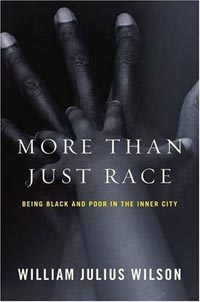The racial divide in America
Interesting comments on a new book:
The wider disputes the Moynihan Report set in motion are anything but ivory-tower squabbles. Liberals charged that the senator’s theory gave ammunition to right-wing arguments for diminished government support of anti-poverty programs. They watched, with growing helplessness, as a crescendo of Republican voices began invoking Moynihan’s writings to defend reduced funding for Head Start, job training, adult literacy, and welfare. Simply put, conservatives argued that blacks needed to change their behavior before money could do any good.
In this way, a deep American schism was born. Liberals believed that black poverty was caused by systemic racism, such as workplace discrimination and residential segregation, and that focusing on the family was a form of “blaming the victim.” Conservatives pointed to individual failure to embrace mainstream cultural values like hard work and sobriety, and intact (read: nuclear) families. It’s like Yankees vs. Mets, and for 40 years there has been no middle ground. (That the current generation of college students might not necessarily share this polarized view may augur an important shift in the years ahead.)
That statement really nails the divide on race in America, doesn’t it?
Conservatives say blacks don’t fit with white values; liberals blame white actions.

There’s no reconciling it. The book cited, More Than Just Race, by William Julius Wilson, pretends to be a new thesis but is a variant on the nurture argument above: white actions caused ghettoes to which minorities have adapted, and in doing so, have taken on bad behaviors.
Barring the absolutely vile racist arguments and the equally off-base “scientific” justification of equality, why not look at the obvious — different populations, evolving in different climates and places, produced genetic inclinations toward different behaviors and values.
Hasse Walum at the Karolinska Institute in Stockholm, Sweden, and colleagues looked at the various forms of the gene coding for a vasopressin receptor in 552 Swedish people, who were all in heterosexual partnerships. The researchers also investigated the quality of their relationships.
They found that variation in a section of the gene called RS3 334 was linked to how men bond with their partners. Men can have none, one or two copies of the RS3 334 section, and the higher the number of copies, the worse men scored on a measure of pair bonding.
Not only that, men with two copies of RS3 334 were more likely to be unmarried than men with one or none, and if they were married, they were twice as likely to have a marital crisis.
There are even differences within populations, but these differences are more pronounced between populations, in addition to other differences that might arise. Those disclaimers out of the way, it’s fascinating that these genes exist, and their tendency to control our behavior explains why we’re afraid of them: maybe we’re not actually in control of ourselves, but are simply machines acting out their programming.
And this cuts to the core of why people adopt the nurture dogma as opposed to others: if we believe in nurture, we get to believe we’re each in control, and that with the right opportunities — not the right innate abilities — we become successes. It gives us a reason to feel humble if we do succeed, and something to blame if we do not.
We love the immutable and tangible nature of this opportunity game. We can justify away any failures by blaming someone else. We can even use it to demonize society at large and claim we do not want to succeed. The possibilities are endless, and our accountability is greatly reduced.
When we apply this to race, it forms a discussion neatly bracketing the issue: whose fault is it? Not the vital question: what’s the best way forward?
In the meantime, in the racial dialogue, there is an unheard voice of the silent majority who want to live with people like them — in race, ethnicity, class, caste, values, customs, and outlook.
A state appeals court in San Francisco today upheld a Berkeley Unified School District policy that considers neighborhood racial composition, but not the race of individual students, when assigning students to schools.
The school district policy classifies students into three diversity categories according to their neighborhoods, which are geographic areas of four to eight city blocks.
Racial composition — or the percent of students of color living in the area — is one of three factors used to determine the neighborhood’s diversity category. The other two factors are average household income and average education level of adult residents.
Steele said, “I think the Berkeley policy charts a path that can be used by other districts that would like a voluntary desegregation plan.”
Why does this come up, again and again? Because we insist that all people are the same, when the truth is that we’re different, just as our ethnic groups are different. Instead of trying to make them equal, implying that if they’re not there’s a problem, why not just accept the differences and then move forward?
Tags: race









